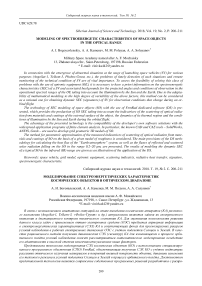Modeling of spectroerergetic characteristics of space objects in the optical range
Автор: Bogoyavlenskiy A.I., Kamenev A.A., Poluyan M.M., Soluyanov A.A.
Журнал: Сибирский аэрокосмический журнал @vestnik-sibsau
Рубрика: Информатика, вычислительная техника и управление
Статья в выпуске: 2 т.19, 2018 года.
Бесплатный доступ
In connection with the emergence of abnormal situations at the stage of launching space vehicles (SV) for various purposes (AngoSat-1, Telkom-3, Phobos-Grunt, etc.), the problems of timely detection of such situations and remote monitoring of the technical condition of SV are of vital importance. To assess the feasibility of solving this class of problems with the use of optronic equipment (OE), it is necessary to have a priori information on the spectroenergetic characteristics (SEC) of a SV and associated backgrounds for the projected angles and conditions of observation in the operational spectral ranges of the OE taking into account the illumination by the Sun and the Earth. Due to the adapta- bility of mathematical modeling to the high degree of variability of the above factors, this method can be considered as a rational one for obtaining dynamic SEC (signatures) of SV for observation conditions that change during an or- bital flight. The technology of SEC modeling of space objects (SO) with the use of FemRad dedicated software (DS) is pre- sented, which provides the production of SO SEC taking into account the indicatrices of the scattering of optical radia- tion from materials and coatings of the external surface of the object, the dynamics of its thermal regime and the condi- tions of illumination by the Sun and Earth during the orbital flight. The advantage of the presented technology is the compatibility of the developer’s own software solutions with the widespread application programs of finite element analysis. In particular, the known CAD and CAE tools - SolidWorks, ANSYS, Gmsh - are used to develop grid geometric 3D models of SO. The method for parametric approximation of the measured indicatrices of scattering of optical radiation from mate- rials and coatings of SO on the basis of a given model of roughness is considered. The main provisions of the DS meth- odology for calculating the heat flux of the “Earth-atmosphere” system, as well as the fluxes of reflected and scattered solar radiation falling on the SO in the range 0.2-20 µm, are presented. The results of modeling the dynamic SEC of a typical SO in the infrared (IR) range are given as an illustration of the application of the DS.
Grid model, scattering indicatrix, radiative heat transfer, signature, space vehicle, optronic equipment, spectroenergetic characteristic
Короткий адрес: https://sciup.org/148321829
IDR: 148321829 | УДК: 629.78 | DOI: 10.31772/2587-6066-2018-19-2-200-211
Текст научной статьи Modeling of spectroerergetic characteristics of space objects in the optical range
Introduction. Over the last 4 years, the total number of active space vehicles (SV) in the near-Earth space (NES) increased by 60 % and exceeded 1900. During the same period, the number of launch vehicles (LV) launches increased by 15 % and tends to increase due to created LV of light and ultra-light classes. Active use of new LV classes increases the urgency of timely detection and remote monitoring of the technical state of the orbited SV in case of loss of communication with them (in particular, abnormal situations aboard the SV AngoSat-1, Telkom-3, Phobos-Grunt, etc.).
Observations of objects in the NES are carried out, first of all, by ground-based optronic equipment (OE) of the visible range, which record their spectrophotometric characteristics. For the visible range, a number of techniques have been developed that make it possible to determine the shape and orientation of space objects (SO) from the results of photometric observations. The disadvantage of OE of the visible range is the difficulty of observing SO in the daytime and when they are in the Earth's shadow. OE surveillance of the IR range allows providing the possibility of round-the-clock receipt of operational information about SO.
The development of consistent hypotheses on the technical state of a SO based on the analysis of the received non-coordinate (signature) information requires the presence of a priori data on the spectroenergetic characteristics (SEC) of a SO in the operating ranges of the OE. Such information can be obtained by the mathematical modeling method, which ensures the production of the SO SEC taking into account the dynamics of its thermal regime change and the conditions of illumination by the Sun and Earth during the orbital flight. It should be noted that the SVs belong to the class of the most complex SOs for the simulation of the SEC, since they are characterized by significant variations in the heat fluxes discharged through the radiation surfaces depending on the operation modes, mutual shading (shielding) of the outer surface portions from the falling (outgoing) radiation fluxes , the surface presence of dissimilar materials and coatings with optical characteristics that vary significantly over time in the complex effect of the NES factors.
In the field of modeling of SV SEC in a wide optical range, there are currently no complete software solutions, which necessitates the joint use of the well-known foreign software tools (STs) SolidWorks, ANSYS, MSC.Sinda / Thermica, Systema V4, AGI STK, COMPASS-3D, THERM and our own specialized modeling tools [1–3].
In this case, the ability to transfer modeling results is provided, as a rule, only between the ST of one Developer or between CAD and CAE tools oriented to finite element analysis. Thus, the 3D geometric model of the SO created in SolidWorks can be exported to ANSYS for using a more advanced grid generation module. However, the resulting geometric model can not be used to simulate external heat transfer of a SV in the ST Systema V4 or TERM. The process of transferring the ANSYS results of modeling the external thermal loads obtained at the TERM ST for a given scenario of a SV orbital motion to thermal analysis environment is quite laborious.
In a number of organizations engaged in the development of SVs and high-resolution information OE, the study of the “Earth–atmosphere” system and space, as well as the solution of other science-intensive problems, there are specialized software solutions of their own design, in which the results of their long-term activity are realized. In particular, such dedicated software (DS) may include unique databases that are not available in the packages of the above-mentioned STs and programs.
The article describes the original technology that provides the interface between modern CAE software and cross-platform open source FemRad DS, designed to develop dynamic SEC (signatures) of a SV, taking into account the design and functional features of a SV and external factors mentioned above [3; 4].
The main stages of the calculation of the dynamic SV SEC and the structure of the FemRad DS. The structural scheme for calculating the dynamic SEC (signatures) of a SV using FemRad DS is shown in fig. 1. The basis of this DS includes a set of interrelated mathematical models, the necessary databases (DB), calculation techniques and application programs implementing them and developed in Fortran-2008 language, which can be used both as a part of the DS developed by the authors and autonomously.
Calculation of dynamic SEC (signatures) of a SV includes the following main stages:
– construction of a grid geometric model (GGM) of a SV, the setting of thermophysical properties of finite elements (FE) and optical properties to elements of the outer surface;
– setting the ballistic parameters of the SV flight and the cyclogram of its operation;
– determination of the relative position of the Sun, Earth, a SV for each moment of time;
– calculation of the matrix of angular coefficients taking into account mutual shielding of the sites;
– determination of the flux density of radiation from the Sun and the ”Earth-atmosphere” system (in the integral and spectral ranges for which the SV SEC are calculated);
– calculation of the falling integral and spectral fluxes from the Sun and the ”Earth–atmosphere” system to the outer surface of the SV GGM taking into account shading and multiple reflections, as well as setting the internal heat of a SV;
– calculation of the temperature of each node taking into account radiant and conductive heat exchange, internal heat release and thermal inertia of a SV design using the FE method;
– calculation of the radiation intensity in the given directions and ranges of the spectrum, as well as the construction of the indicatrices of the radiation intensity of a SV for all set wavelength ranges.
Construction of a SV grid geometric model. The construction of a SV GGM begins with a preparatory stage, which includes analysis of the constructive and functional features of the modeling object and the development of its three-dimensional geometric model (CAD model) by means of automated design. Any ST intended for 3D modeling can be used for this purpose. It is expedient to select a ST that allows importing / exporting files in various graphic formats, including the widely used STEP format (AP 203 protocol), supported by international and domestic standards (GOST R ISO 10303).
Physical volumes and surfaces of a SV CAD-model are marked out in order to preserve information about the thermal and optical properties of various elements of a SV. Each physical volume (surface) combines adjacent elements of a SV, which have the same thermophysical (optical) properties.
Generation of the calculated SV GGM on the basis of four-node tetrahedrons as the FE is carried out using the cross-platform open ST Gmsh [5]. ST ANSYS can also be used for this purpose. In this case, the obtained grid model is reduced to the ST Gmsh format by means of a special converter [6].
Calculation taking into account changes in the angular position: ■ angular coefficients ■ shading
■ direct solar radiation
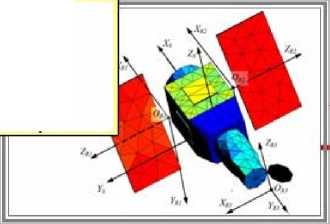
Import of SO geometric models from CAD systems, obtaining grid models
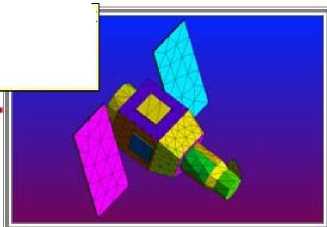
Calculation of mutual position of a SO, the Earth and the Sun
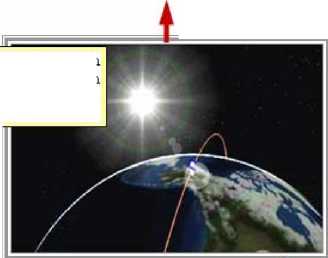
Calculation of spectral distributions effluxes:
■ thermal radiation of the Earth (3 ... 20 pm)
■ solar radiation scattered by the atmosphere (0.3
... з 1^
■ solar radiation reflected from the Earth's surface
(0.3 ...3 pm)
Calculation of the temperature field of a SO by the finite element method
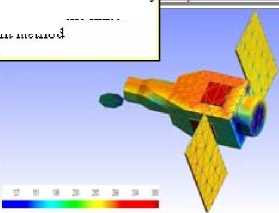
DB for thermal and optical characteristics of SO materials and coatings
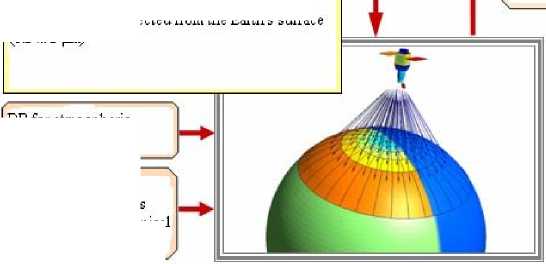
DB for atm о sphene parameters
Fig. 1. Structural scheme for the calculation of dynamic SV SEC using FemRad DS
DB for the spectral emission coefficients and the albedo of typical surfaces of the Earth
Calculation of the dynamic spectroenergetic characteristics of a SO
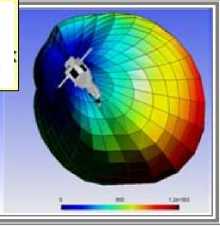
Рис. 1. Структурная схема расчёта динамических СЭХ КА с использованием СПО FemRad
Information about the attribution of each element of the grid to any physical volume or surface is stored in the output file. All areas, normals and coordinates of the center of all surface triangular areas of GGM (facets of FE tetrahedrons) are calculated in the coordinate system (CS) associated with the SV.
Setting of thermophysical properties of FE and optical properties of the external surface is carried out on the basis of the analysis of their belonging to some physical volume or surface. Material is set for each physical volume, and a set of integral and spectral optical characteristics is set for each surface. Density, specific heat and coefficient of thermal conductivity are set for volumetric elements; the absorption coefficient of solar radiation, the degree of blackness, the approximation coefficients of the indicatrix of the reflected radiation scattering in the spectral ranges in which the SV SEC are calculated are set for materials (coatings) of external surfaces. In the visible range the indicatrix of the dimensionless brightness factor β , and in the IR range the bidirectional reflection function (BRF) ρ′ with a dimension of 1 / sr. are meant as the indicatrices of reflected radiation scattering.
Approximation of the indicatrices of the scattering of optical radiation from materials and coatings on the outer surface of a SV. A parametric dependence based on a given model of surface roughness is used to approximate the experimentally obtained indicatrices β and ρ′ [7]. It includes terms describing the specular and diffuse components of the reflected radiation:
β = βm(θi)·G·D/(cosθi·cosθr) + βd, ρ′ = ρ′m(θi)·G·D/(cosθi·cosθr) + ρ′d, where θi is the angle between the direction of the incident radiation and the normal to the surface; βm(θi) is maximum value of the brightness coefficient at angle θi; G is a geometric factor, taking into account the influence on the shape of the surface roughness indicatrix; D is the multiplier characterizing the probabilistic distribution of roughness; θr is the angle between the normal and the direction of observation; βd is the brightness coefficient of the diffuse component of the reflected radiation; ρ′m is the maximum of the BRF at angle θi; ρ′d is the BRF value of the diffuse reflection component.
A detailed derivation of expressions for calculating the values of G and D is given in [7].
As an example, fig. 2 shows the results of the approximation of the indicatrix of the brightness coefficient of the enamel sample EP-255 for radiation with a wavelength of 0.48 μm, and fig. 3 shows the results of BRF approximation of a mylar film for radiation with a wavelength of 9.6 μm. The solid lines in these figures show the measured values, the dotted ones show the results of the approximation.
The obtained parametric approximations of the scattering indicatrices of the reflected radiation for a given spectral range are included in the DB on the thermal and optical characteristics of the materials and coatings of the SO, used in the calculation of the SV SEC with the use of the FemRad DS.
Modeling of the orbital motion, kinematics of a SV and its moving parts. To simulate the motion of a SV in orbit, the following parameters are set in SEC: the inclination of the orbit, the height of the apogee and perigee, the longitude of the ascending node, the argument of the perigee latitude, the true anomaly, as well as the calendar date and the universal time (UTC) at the end of the calculation. Determination of the relative position of the Sun, the Earth and a SV at the present moment (step) includes calculating the coordinates of the center of mass of a SV, direction vectors from the center of mass (CM) to the Sun and to the center of the Earth in an absolute geoequatorial CS. At each time step it is checked whether a SV is illuminated by the Sun or is in the Earth’s shadow.
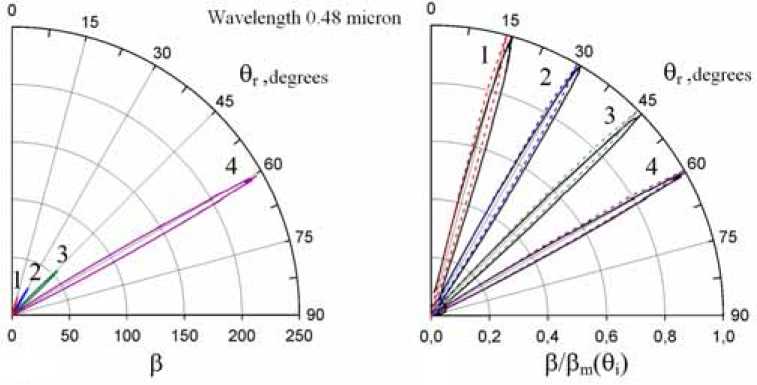
a
b
Fig. 2. The measured absolute ( a ) and normalized ( b ) values of the brightness coefficient of the enamel EP-255 at the angle of radiation incidence on sample θ i , degrees:
1 – 15; 2 – 30; 3 – 45; 4 – 60
Рис. 2. Измеренные абсолютные ( а ) и нормированные ( б ) значения коэффициента яркости образца эмали ЭП-255 при угле падения излучения на образец θ i , град.: 1 - 15; 2 - 30; 3 - 45; 4 - 60
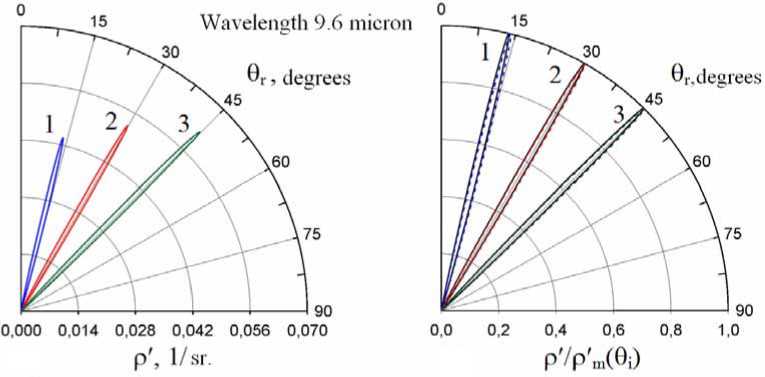
a
b
Fig. 3. Measured absolute ( a ) and normalized ( b ) BRF values of a mylar film sample at an angle of radiation incidence on sample θ i , degrees: 1 – 14; 2 – 30; 3 – 45
Рис. 3. Измеренные абсолютные ( а ) и нормированные ( б ) значения ДФО образца плёнки ПЭТФ при угле падения излучения на образец θ i , град.: 1 - 14; 2 - 30; 3 - 45
If a SV makes rotational movements relative to the CM and / or its moving parts (solar panels (SP), covers of optical systems, etc.) make movements with respect to the SV body during its functioning, then a kinematic model and a cyclogram of the kinematics of the object are set.
A kinematic model is a two-level system of kinematic bodies (KBs) and connections between them. A SV body is a kinematic body of the upper level, or the main kinematic body, and SV moving parts or mobile kinematic bodies (MKBs) are the bodies of the lower level. A number of degrees of freedom and lists of the physical volumes and surfaces included into it are set for each KB. Parameters defining the position of a MKB in the construction CS of a SV, such as, the coordinates of the origin of the mobile CS associated with the KB and the unit vectors of its axes are additionally set for MKBs.
A kinematics cyclogram is set in the form of a sequence of kinematic phases. A kinematic phase (KF) is the time interval during which the laws and parameters of motion of all KBs remain unchanged. A KF is characterized by the time of its beginning, termination, and the type of a SV orientation in this phase (to the Earth, to the Sun, to the velocity vector). The laws and parameters of KBs’ rotational motion relative to the axes corresponding to the degrees of freedom defined for these bodies are set on each KF for all KBs.
Calculation of angular coefficients. Calculation of the angular coefficients (AC) between the platforms of the SV GGM is carried out by the method of double integration over area, taking into account the shielding factor [8]. In view of the extremely high laboriousness of calculating AC with shielding by direct scanning of screen areas, an accelerating structure based on one of the varieties of an uneven volume grid is used to solve this problem. The same accelerating structure is used for tracing the path of the rays, taking into account their multiple reflections, and also in calculating the shielding of radiation leaving the SV towards the observer.
When the configuration of the object is changed in accordance with the kinematics cyclogram (for example, when rotating the SPs, opening the covers, etc.), the AC matrix and the accelerating structure are recalculated taking into account the changed characteristics of the mutual shielding of the platforms, and their coordinates and normals are recalculated as well.
Simulation of the SEC of the “Earth–atmosphere” system radiation. The technique according to which the Earth (as a source of illumination) is considered as a diffusely radiating and reflecting spherical body [9] is traditionally used when calculating the thermal regimes of a SV and the intensity of their own radiation. In this case, the Earth's albedo is assumed to be constant over the Earth’s entire surface, and its intrinsic radiation is determined either as the radiation of an absolutely black body with a given temperature, or is directly set in the form of radiation fluxes from a unit surface of the planet. The optical characteristics of the materials and coatings of SVs are given as weighted averages for the selected spectral range. This technique is also implemented in FemRad DS, where it is used in those cases when the calculation problems are limited to determining the temperature field of the outer surface and the integral radiation intensity of a SV. However, it is of little use for calculating the SV SEC in narrow spectral ranges due to the significant errors that arise. The latter is due not only to the manifestation of the selective properties of the reflective-radiative characteristics of materials and coatings on the outer surface of a SV, but also to the pronounced selective nature of the radiation of the “Earth–atmosphere” system as a source of a SV illumination.
Therefore, another technique is also implemented in the FemRad DS, which allows calculating the heat radiation fluxes of the “Earth–atmosphere” system and the reflected solar radiation taking into account their spectral structure. According to this technique, the solid angle of the Earth's surface visible from a SV orbit is divided radially into a plurality of equal illumination zones for each of which conditions of lighting by the Sun are determined at the time of calculation (not lit, lit completely, lit partially). Zone centers are considered as point sources of radiation, from which optical paths (OPs) are set in the direction of a SV CM (fig. 4). Each zone is associated with one of the types of underlying surfaces (US) of the Earth, represented in the DB of optical characteristics of typical landscapes. This DB includes systematic data on the spectral emission and reflection coefficients as well as spectral albedo of typical US (water, snow, cloud cover, desert, forest, etc.) in the ultraviolet, visible, and IR ranges (0.2–25.0 μm). When a SV moves in the orbit the system of illumination zones formed around the subsatellite point (fig. 4) moves together with it over the surface of the Earth, so that the USs in each zone are continuously changed with regard to their actual geographic location and seasonal variation.
The optical thickness and the transmission coefficient along the OPs as functions of height are calculated for each illumination zone. These data are used to solve the equation of radiative transfer along the OPs for calculating the luminance field values at the upper atmosphere boundary (UAB) in the direction from the center of the zone to the SV CM. Traces of rays in the Earth's atmosphere are calculated taking into account refraction. The spectral density of the energy brightness (SDEB) of the radiation of the illumination B λ , coming to the UAB from each zone, is calculated as the sum of the contributions of several components:
Bλ = BλSR + BλIR + BλAH, where BλSR is the contribution of solar radiation reflected from the US; BλIR is the contribution of the intrinsic thermal radiation of the US; BλAH is the contribution of atmospheric haze radiation.
SDEB of radiation of atmospheric haze is calculated as the sum of contributions of the following components:
B λAH = B λAA + B λAM + B λTR , where Bλ AA is the contribution of solar radiation scattered by atmospheric aerosols; B λAM is the contribution of solar radiation scattered by air molecules (Rayleigh scattering); B λTR is the contribution of the thermal radiation of the atmosphere.
All the radiation components in the above formulas are considered independent and are calculated taking into account the attenuation of radiation as it propagates in the Earth’s atmosphere. The received brightness field on the UAB is used to calculate the radiation flux density coming from the illumination zone in the direction of the SV CM by integration over the solid angle of its visibility and the given spectral subbands. These operations are performed for each zone.
The verification of the developed methods and programs for the calculation of SEC of the “Earthatmosphere” system was carried out in three stages by comparing the results obtained with their help with the results of field experiments and simulation results using specialized software.
At the first stage, private base techniques were tested to perform calculations of the refractive indices of dry and moist air, the scattering cross section and the optical depth of molecular scattering, and other auxiliary parameters.
At the second stage, a set of test calculations of the SDEB of the ”Earth–atmosphere” system in a wide optical range for typical situations and observation conditions was performed. As an example, fig. 5 presents calculated and experimental data on the SDEB of a typical underlying surface of the Earth.
At the third stage, the correctness of the calculation of the integral radiation fluxes from the ”Earth–atmosphere” system to the set point of the NES was verified.
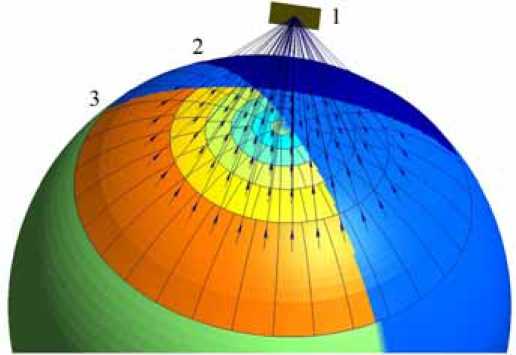
Fig. 4. The scheme of irradiation of a SV platform by the surface of the ”Earth–atmosphere” system, divided into 91 illumination zones: 1 – is a platform; 2 – is a boundary between the illuminated and shadow parts of the Earth; 3 – is the trace of the intersection of the platform plane with the Earth’s surface
Рис. 4. Схема облучения площадки КА поверхностью системы «Земля–атмосфера», разбитой на 91 зону подсветки: 1 - площадка; 2 - граница между освещённой и теневой частями Земли;
-
3 - след пересечения плоскости площадки с поверхностью Земли
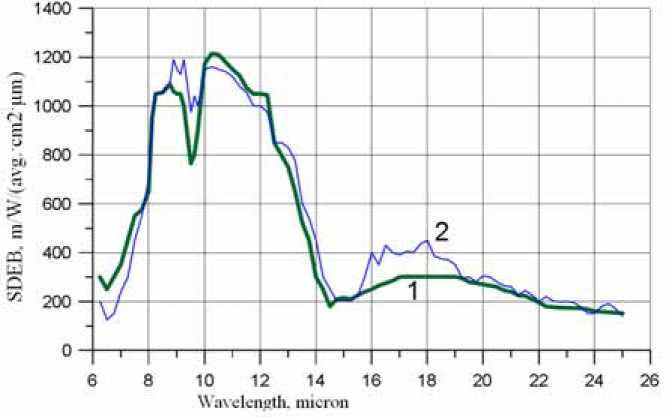
Fig. 5. SDEB of the underlying Earth's surface: 1 – is data recorded by the MSRF-IC equipment when observed in a nadir from a height of 300 km (Libyan desert, summer, day [10]);
2 – is calculation for a height of 300 km (seasonal-regional model of the atmosphere – standard, the temperature of the underlying surface (sand) + 50 °C)
Рис. 5. СПЭЯ подстилающей поверхности Земли: 1 – данные, зарегистрированные аппаратурой МСРФ-ИК при наблюдении в надир с высоты 300 км (Ливийская пустыня, лето, день [10]); 2 – расчёт для высоты 300 км (сезонно-региональная модель атмосферы - стандартная, температура подстилающей поверхности (песок) +50 ° С)
According to the published data, the average power density of the intrinsic thermal radiation of the “Earth– atmosphere” system on the UAB in a cloudless sky is 265 W/m 2 [11]. The calculated value of this value, obtained with the use of the DS, was 264 W/m 2 for the standard model of the Earth’s atmosphere.
Analysis of the results of DS testing showed that the developed methods and programs ensure the calculation of the incoming heat fluxes entering the given point of the NES, as well as the flux of solar radiation reflected and scattered by the ”Earth–atmosphere” system in the optical range of 0.2–20 μm with the required accuracy.
Calculation of the heat fluxes arriving at a SV. Calculation of the integral and spectral fluxes from the Sun and the ”Earth–atmosphere” system falling on the platforms of the outer surface of the SV GGM is done taking into account shading and multiple reflections. Z-buffer method is used to calculate the shading [12]. In accordance with this method, the SV GGM is projected onto flat screens perpendicular to the corresponding directions on the Sun and the illumination zones of the “Earth– atmosphere” system (fig. 6). Surfaces of screens are broken into elementary fragments of the image – pixels by an orthogonal grid. The midsection area relative to the radiation flux of the source in question equal to the sum of the areas of all the pixels occupied by it in the z -buffer is calculated for each platform. The radiant flux incident on this platform from the source of illumination is determined by the product of its flux density on the area of the midsection of the platform. The total radiant fluxes to the platforms of the SV GGM SC are determined by the sum of the fluxes from all external sources.
An incident flux is traced in the platform system of a grid model in the presence of materials and coatings on the surface of a SV characterized by the presence of a mirror component in the reflected radiation, taking into account its multiple reflection (separately for each source). The external surface platforms at which incident radiation arrives directly are considered as sources whose radiation is propagated further in the platform system along the paths calculated using the accelerating structure (fig. 7). Using the trace algorithm the trajectory of each ray is traced until it is either completely absorbed or leaves the platform system. It is taken into account that in each reflection cycle, both diffuse and specular components may be present in the reflected radiation depending on the type of material (coating) of the surface. The transfer of radiation reflected diffusely is calculated using the AC matrix.
The internal heat dissipation of a SV is set in the form of the mid-turn heat-release cyclograms for the corresponding physical volumes.
Calculation of the non-stationary temperature field of a SV . The calculation of temperatures in the nodes of the SV GGM grid is carried out by the finite element method. In accordance with this method, the initial non-stationary heat equation is transformed by the Galerkin method into a matrix system of four equations for each FE in the form of a tetrahedral tetrahedron. In the resulting system of equations, the unknowns are the temperatures at the nodes of the FE.
Matrix systems of equations for individual FEs are assembled into a global system of linear algebraic equations for the entire grid model of a SV. The original algorithm for compact storage of sparse matrices [13] is implemented in the DS, which allows significant increasing the speed of calculations and reducing the amount of required RAM.
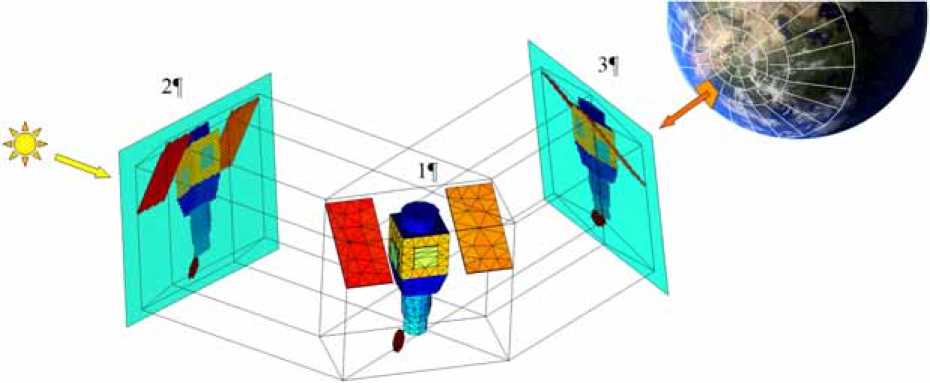
Fig. 6. The scheme of calculation of radiant fluxes incident on a SV using z -buffer: 1 – is a SV GGM;
2 , 3 – are projections of the SV GGM in the plane perpendicular to the direction of radiation fluxes of external sources: the Sun ( 2 ), the illumination zones of the ”Earth–atmosphere” system ( 3 )
Рис. 6. Схема расчёта падающих на КА лучистых потоков с использованием z -буфера: 1 – СГМ КА; 2 , 3 – проекции СГМ КА на плоскости, перпендикулярные направлению потоков излучения внешних источников: Солнца ( 2 ), зоны подсветки системы «Земля–атмосфера» ( 3 )
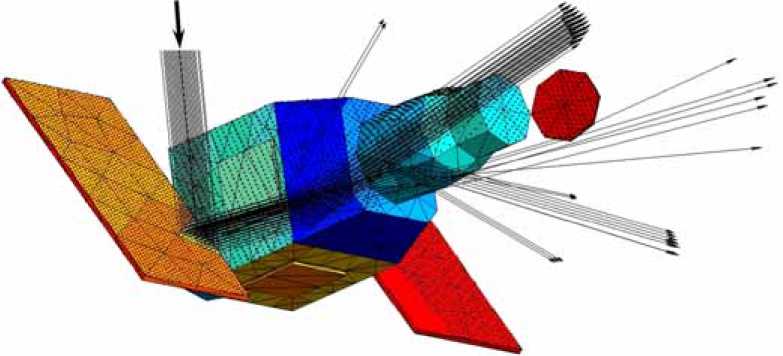
Fig. 7. An example of ray tracing for one of the platforms of the SV GGM. The arrow shows the direction of radiation of the source, the points show the beginning of the traces of reflected rays
Рис. 7. Пример трассировки лучей для одной из площадок СГМ КА: стрелкой показано направление излучения источника, точками – начало трасс отражённых лучей
As a result of solving the obtained global system of equations, temperatures are calculated at all nodes of the grid, with the exception of the nodes belonging to the outer layer of screen-vacuum thermal insulation (SVTI). The temperature of the outer surface of the SVTI irradiated by the Sun and the ”Earth–atmosphere” system dynamically changes at each step in time due to the low thermal inertia of the film layers. Therefore, the temperature at the nodes of the SV grid model belonging to the surface layer of the SVTI is determined as a result of solving the instantaneous equations of stationary heat exchange taking into account the thermal bonds with the inner layers of thermal insulation.
Simulation of a SV dynamic SEC (signatures). Calculation of a SV radiation intensity (integral one and in given spectral ranges) is performed simultaneously for the set of directions uniformly distributed in the solid angle 4π avg. For example, when setting the step between directions 30, their number is 7082, at step 20 it is 16022. The outgoing radiation for each direction is calculated taking into account the mutual shielding of the platforms of a SV GGM. All the components of the radiation leaving a SV, such as, its own thermal radiation, reflected solar radiation, the thermal radiation of the Earth and the solar albedo-flow of the Earth are included. The set of values of the flows leaving in all directions forms the indicatrix of the radiation intensity of a SV. The set of such indicatrices (integral ones and in given spectral ranges), calculated for each time step within one or several turns and stored in files of a certain format, represent a digital dynamic model (DDM) of a SV SEC. The file containing the temperature field of a SV for each step in time is recorded in parallel with the DDM SEC files. DDM SEC and a SV temperature field files can be viewed and analyzed both in a step-by-step and in a 3D animation mode with the use of the post processing facilities of the Gmsh ST.
Indicatrices of a SV radiation intensity are visualized in the form of projections onto the opaque spherical screen surrounding it (fig. 8). The center of the screen is placed in a SV CM. Each value of the radiation intensity on the screen corresponds to a certain shade of the color scale. To transfer the shape of the indicatrix, a spatially non-uniform transformation of the spherical screen into a 3D surface can also be used, so that the length of the radius-vector of any point of the surface is proportional to the radiation intensity in the direction given by this vector.
The results obtained in modeling the SEC of a typical SV in the IR range of 3–20 μm are given below to illustrate the application of the FemRad DS. A low-mass SV with a characteristic design (fig. 9) in the main elements of which analogues of widely used materials and coatings of their external surfaces are used was selected as the object of research. Solar cells based on gallium arsenide are located on the front side of the SB panels, and their backside is covered with white enamel of AK-512 type. An aluminized polyimide film of the NIIKAM-KPMA type is used as the facing layer of SVTI. A thermoregulatory coating of TR-SO FSr type is applied on the radiation surfaces. A SV operates on a circular sun-synchronous orbit with a height of 480 km and with inclination of 97.4 0 .
Fig. 9 shows the relative position of a SV, the Earth and the Sun, and the numbers indicate the characteristic points of the orbit: point 1 is 10 seconds before a SV leaves the Earth’s shadow; points 2, 3 are located above the north pole and the equator of the Earth, respectively; point 4 corresponds to the maximum SB temperature of a SV.
The simulation results are shown in fig. 10. As it can be seen, the spatial indicatrix of a SV radiation is distinguished by a significant inhomogeneity in the directions of observation, and also considerably depends on the position in the orbit.
It should be noted that since solar cell batteries are located in a plane perpendicular to the longitudinal axis of a SV, radiation from the panels of the SB goes in the –X direction, and radiation from a SV body (SVTI and radiators) goes mainly in the +Y direction. At the same time, the temperature of the SVTI facing layer on the illuminated side is, on average, close to the temperature of the SB panels. The maximum values of the integrated radiation intensity (IRI) in the range 3–20 μm are achieved in the ±X directions, that is, perpendicular to the SB panels. In this case, the indicatrix of a SV IRI acquires a dumbbell shape. This is due to the fact that the area of the body midsection is smaller than the area of the SB panels. The close dimensions and shapes of the ”dumbbell” halves (in the +X and –X directions) are due to the small temperature difference between the front and back sides of the SB panels, as well as the close values of the solar cell emission coefficient (ε = 0.88) and white enamel AK-512 (ε = 0.85).
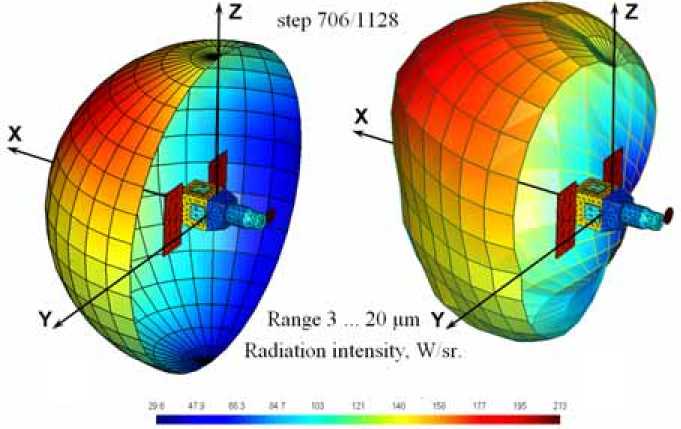
a b
Fig. 8. Visualization of the indicatrix of the SV radiation intensity using the surrounding opaque 3D screen (shown in the section). The spatial unevenness of the radiation intensity is transmitted by: the color gradient ( a ); the color gradient and the length of the radius vectors of the grid nodes ( b )
Рис. 8. Визуализация индикатрисы силы излучения КА с использованием окружающего его непрозрачного 3D-экрана (показан в разрезе). Пространственная неравномерность силы излучения передаётся: градиентом цвета ( а ); градиентом цвета и длиной радиусов-векторов узлов сетки ( b )
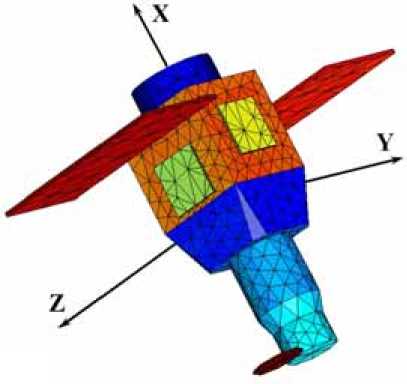
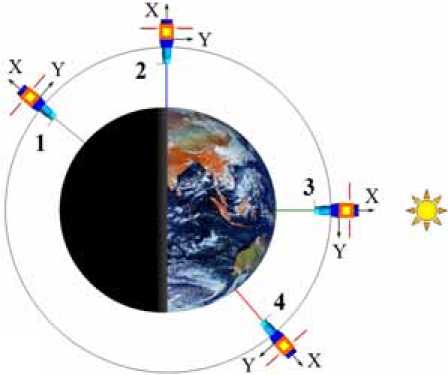
a
b
Fig. 9. Grid finite element model ( a ) and the position of a SV at the characteristic points of the orbit ( b ) in the calculation of its SEC
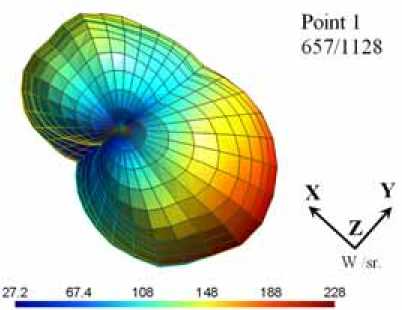
Рис. 9. Сеточная конечно-элементная модель ( а ) и положение КА в характерных точках орбиты ( б ) при расчёте его СЭХ
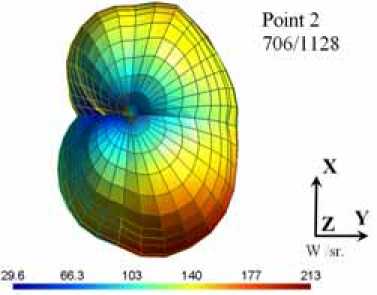
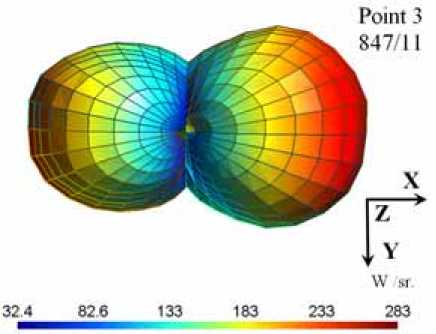
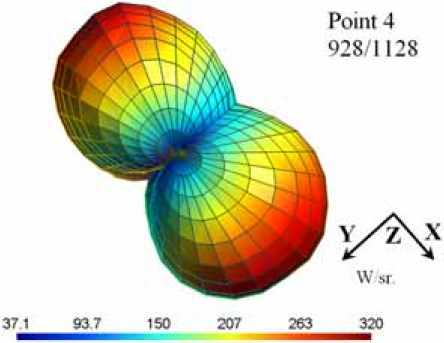
Fig. 10. Indicatrices of a SV radiation intensity in the range 3–20 μm at the characteristic points of the orbit (the numbering of points and a SV orientation in them correspond to fig. 9)
Рис. 10. Индикатрисы силы излучения КА в диапазоне 3–20 мкм в характерных точках орбиты (нумерация точек и ориентация КА в них соответствуют рис. 9)
The main feature of a SV SEC in the IR range is the presence of the object's own radiation at any time, irrespective of its illumination by the Sun. In addition, the reflected radiation from the “Earth–atmosphere” system contributes to the emission of low-orbit SVs. Thus, the minimum value of the IRI at point 1 in the shadow portion of the orbit is 23 W/sr.
Thus, ground-based OE of the IR range has the advantage of the duration of SO observations compared to OE operating in the visible range. At the same time, the maximum values of IRI in the IR range are substantially lower than the IRI in the visible range of the electromagnetic spectrum
Conclusion. FemRad DS developed as a set of interconnected calculation methods, models, databases and software modules implementing them can be used to solve the following urgent scientific and applied problems:
– calculation of dynamic SEC (signatures) of a SV, taking into account multiple reflections of the incident radiation fluxes from the Sun and Earth by the elements of its surface, shadowing of some SV elements by others in the direction of the observation OE and data on the reflection, radiation and scattering indicatrices of the optical radiation of the samples of materials and a SV surface coatings obtained experimentally;
– calculation of the SEC (spectral, integral transmission and brightness ones) of atmospheric routes for real conditions of a SO observation in the process of its accompanying by ground-based OE;
– ssessing the capabilities of the ground-based OE to detect SVs in the forecasted observation conditions using the calculated values of SEC of the atmospheric routes.
The development of the presented technology is the use of software environment that acts as a single platform for the organizations of Russian space industry, containing standardized basic elements (including ballistic support, DS, databases on the solar SEC emission, the “Earth–atmosphere” system and space, etc.) It allows integrating various calculation methods and software.
Список литературы Modeling of spectroerergetic characteristics of space objects in the optical range
- Залетаев С. В., Копяткевич Р. М. Программный комплекс теплового проектирования и анализа тепловых режимов космических аппаратов // Космонавтика и ракетостроение. 2014. № 4 (77). С. 84-91.
- Тепловой анализ негерметичного приборного отсека космических аппаратов / В. Г. Бутов [и др.] // Известия вузов. Физика. 2010. Т. 53, № 12 (2). С. 49-54.
- Моделирование спектроэнергетических характеристик космических объектов в оптическом диапа- зоне / А. И. Богоявленский [и др.] // Радиопромышленность. 2014. № 1. С. 147-154.
- Каменев А. А., Самородов А. А. Применение баз данных по космической фоноцелевой обстановке для реализации технологии информационной поддержки ОЭС наблюдения в процессе жизненного цикла // Вопросы радиоэлектроники. Сер. «Техника телевидения». 2017. Вып. 2. С. 11-18.
- Geuzaine C., Remacle J.-F. Gmsh: a three- dimensional finite element mesh generator with built-in pre- and post-processing facilities // International Journal for Numerical Methods in Engineering. 2009. Vol. 79, iss. 11. P. 1309-1331.

